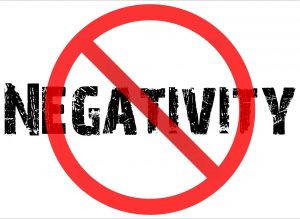Why all the negativity? We live in a world where being negative, slamming the ideas of others, or being divisive for our own gain is sadly quite common. Negativity may show itself in organizations in many different ways. Complaining, that endless droning on from Debbie Downer, can suck the energy out of a room in under two seconds. Jon Gordon refers to these people as ‘Energy Vampires’. Dismissing ideas or immediately stating why something won’t work is another timeless classic. My personal favorite, passive aggressive behavior, the eye-roll, or even agreeing to some effort or initiative and then doing the opposite when no longer around the group. Great leaders know that negativity must not be allowed to persist in their organizations. It’s one thing to make the statement, another to actually do something about it. But how do leaders address negativity, complaining, and the like in a manner that can be productive and move the collective forward? Here are few methods I have found effective when dealing with negativity.
1. Be aware and mindful of what people say and how they say it.
- Have you ever experienced that sense of relief when that really negative person leaves your organization? Everyone feels like the weight of the world is lifted from their shoulders. Yet somehow, somebody is waiting in the wings to fill the void. Being aware of who that ‘dark knight’ might be is often as easy as listening intently to what people say and how they say it. Sometimes that dark knight has been waiting their turn and they seize the chance. But if you are cognizant of their behaviors and patterns, you can head this one off at the pass. Turning that negativity by simple conversations, clarifying questions, and requests for evidence to support their claims will let them know you are hearing them and giving them the attention they crave.
2. Confront negative and destructive behaviors.
- There is an old saying that, in its essence, says ‘what you don’t address you endorse’. In other words, if you don’t confront the negative behaviors, statements, attitudes, and such you are telling those in your organization that you support, even endorse, those negative actions. Great leaders, those who lead with an eye on culture, know this is the worst thing one can do for team culture. Sometimes this is one of the more difficult steps to take, but once you are willing to have those face to face conversations, to let the ‘Negative Nellie’s’ know that you won’t accept their behavior as part of your team, you take a giant step forward toward ensuring positive, productive culture and climate in your organization. Keep in mind, you don’t have to, nor should you, be a ‘jerk’ when you address negativity. Simply reminding team members of your norms, expectations, and values may do the trick. For the particularly rogue agent, you may have to sit down, one-on-one to discuss why they feel the need to bring their poison to the party. Be brave and address that negative energy.
3. Have high expectations, not high hopes.
- Ok, what’s the difference? I have many times had the conversation with teachers and leaders who aren’t getting what they want or expect from students or adults. I always ask, ‘what are your expectations?’ Usually people say they have high expectations, and that’s fine, provided they are willing to hold people to those expectations. I am a true believer of the ‘rise and fall principle’. By that, I mean, people will rise or fall to the level of expectation you are willing to hold them to. If you say your expectations are high but lower the bar on what you accept, truth is all you have are high hopes.
4. Hold yourself to the highest standard.
- You cannot expect one thing of people then behave a different way, in any setting. Never forget, as leaders we are always on stage. There exists a gap in leadership knowledge. Many of our leaders fall down when it comes to the litmus test of the double standard. Great leaders know they cannot separate themselves from those they lead when it comes to meeting the standard. Mike Tomlin, the Pittsburgh Steelers head coach, famously says ‘The standard is the standard’, meaning no matter who and no matter their role, all are held to the same standard. As a leader, if we don’t hold ourselves to the standard, or hold differing standards for different employees (this will get you accused of playing favorites in a blink), we are sunk.
5. No complaining…well, yeah, no complaining.
- One of the best books I’ve ever read, The No Complaining Rule by Jon Gordon, outlines a strong plan for ensuring complaining can be productive and not a negative activity. Essentially, complaining will not be acceptable except under certain conditions. First, you have to complain to someone who can actually help you solve the problem. Second, bring a solution to the problem. Third, be open to problem solving. Its that simple. I have used this in the past, to which I got some complaining from my #1 Barbie Bummer. What she didn’t realize at the time was that it was her circle of influence who asked me to do something about the endless whining and bitching. She complained to her group about the ‘no complaining rule’ and they finally had enough of her. Do all you can to shut down complaining, because it spreads like wildfire.



Be First to Comment